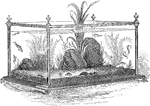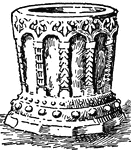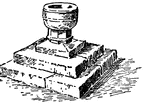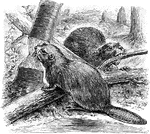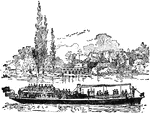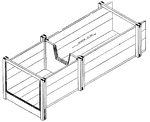Acipenser Sturio
A type of Ganoid fish. Ganoid is an order of fishes included seven living genera, whose members are…

Seal of Alaska
The Seal of the District of Alaska, 1911. The image on the seal shows Alaska's mountains and shore.
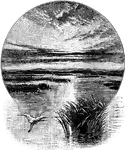
Amazon River
The Amazon River is the largest, most voluminous river on earth, having a greater total flow than the…
Amia Occidentalis
A type of Ganoid fish. Ganoid is an order of fishes included seven living genera, whose members are…
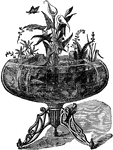
The Aquarium
"An aquarium well filled and stocked with plants, fish, etc., is one of the finest ornaments one can…
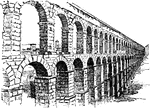
Aqueduct
"Aqueduct of Segovia, Spain. A conduit or channel for conducting water from one place to another."-Whitney,…

Aqueduct
"A conduit for conveying water more particularly applied to structures for conveying water from distant…
Roman Aqueduct
"Part of a Roman Aqueduct. Aqueducts form one of the most characteristic features of Roman architecture.…
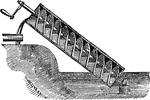
Archimedes Screw
"A machine for raising water, said to have been invented by Archimedes, during his stay in Egypt for…
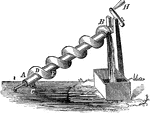
Archimedes' Screw
"Invented to raise water. A hollow tube wound spirally around a solid cylinder. As the cylinder is turned,…
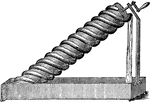
Archimedes' Water Screw
"It consists of a tube, made of lead, or strong leather, coiled round a cylinder of wood or iron, as…
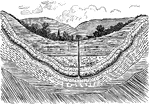
Artesian Well
Artesian Wells differ from ordinary wells in that their waters are discharged by natural pressures on…
Coral Island of Atoll
"Atolls. A coral island commonly consists of a narrow rim of reef, surrounding a lagoon." -Dana, 1880
Section of Coral Island of an Atoll
"represents a section of an island, from the ocean (o) to the lagoon (l). On the ocean side, from o…
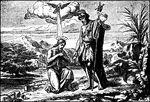
The Spirit of God Descends on Jesus When He is Baptized by John the Baptist
"And Jesus when he was baptized, went up straightway from the water: and lo, the heavens were opened…

Baptismal Font at Eastdown
This illustration shows the baptismal font at Eastdown in England. It is made of stone and wood.
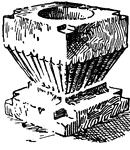
Baptismal Font at Lydbury North
This illustration shows the baptismal font at Lydbury North in England.

Baptismal Font at Smithfield
This illustration shows the baptismal font at Smithfield, London, England.
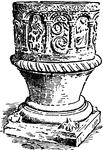
Baptismal Font at Tidenham
This illustration shows the baptismal font at Tidenham, near Chepstow, in England.
Barometer
"Suppose a to be a long tube, with the piston b so nicely fitted to its inside, as to work air tight.…
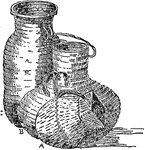
Native American Baskets
An illustration depicting Native American water vessels: A. Iroquois vessel of birchbark. B. Zuni woven…

Bean Plant in Jar
"The bean with its roots in unboiled water will grow for a considerable time, as long as the mineral…
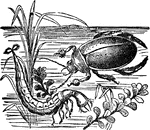
Great Diving Beetle
"A, Dytiscus Marginalis, or great Water-beetle; B, larva." — Chambers' Encyclopedia, 1875

Predaceous Beetle
Predaceous diving beetles is a family of water beetles. They are about 25 mm (one inch) long on average,…
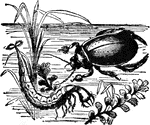
Water Beetle
"Water Beetles are beetles which live on or in the water. The Dytiscus, common in stagnant water, is…
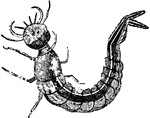
Water Beetle Larva
Water beetles carry air bubbles under their abdomens, which provides an air supply. Water beetle larvae…
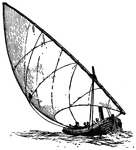
Boat with Lateen-sail
A lateen-sail is a triangular sail extended on a yard which is slung one quarter from the lower end…

Boy Watching Tea Kettle in Fireplace
An illustration of a young boy sitting on a stool watching a tea kettle in a fireplace.
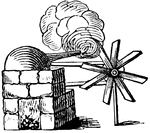
Brancas Engine
"In 1629 Giovanni Branca, an Italian, contrived a machine which was employed for the various purposes…

Breast Wheel
"In this water, instead of passing over, or entirely under the wheel, is delievered in the direction…
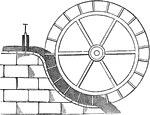
Breast Wheel
"Water enters the wheel halfway up and flows against the slots on the wheel. The wheel rotates with…
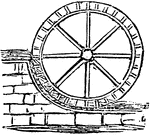
Breast-wheel
"A wheel turned by the force of water which is level with its centre." — Williams, 1889

The Brook
The Brook is an engraving on a wood block that was created by Edward Calvert, an English printmaker…

Assyrian Bucket
This Assyrian bucket is designed with a cord handle and terminates at the bottom with a lion mask. It…

Graeco-Italic Bucket
This Graeco-Italic bucket is made out of bronze. It has a ring foot bottom with two hoop handles. It…
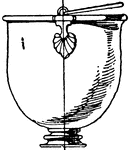
Graeco-Italic Bucket
This Graeco-Italic bucket is made out of bronze. It has a ring foot bottom with a hoop handle. It was…

Graeco-Italic Bucket
This Graeco-Italic bucket is made out of bronze. It has a ring foot bottom with two hoop handles. It…

Graeco-Italic Bucket
This Graeco-Italic bucket is made out of bronze. It has a footless bottom resembling an inverted egg.…
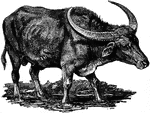
Domestic Water Buffalo
The Domestic Water Buffalo or Domestic Asian Water buffalo (Bubalus bubalis) is abundant in Asia, and…

Capillarity
Capillarity. On the left, water is higher in the smaller tubes due to adhesion. On the right, mercury…

Capillary Attraction
"b is a glass tube in water and c is a glass tube in mercury. The surface of the water in the tube b…

Cardinal de Richelieu Towing Cinq-Mars and de Thou
"Cardinal de Richelieu Towing Cinq-Mars and de Thou. From the painting by Paul Delaroche." -Rees, 1894

Centaur & Man Standing on Shore
An illustration of a centaur and man standing on the shore of a lake.
